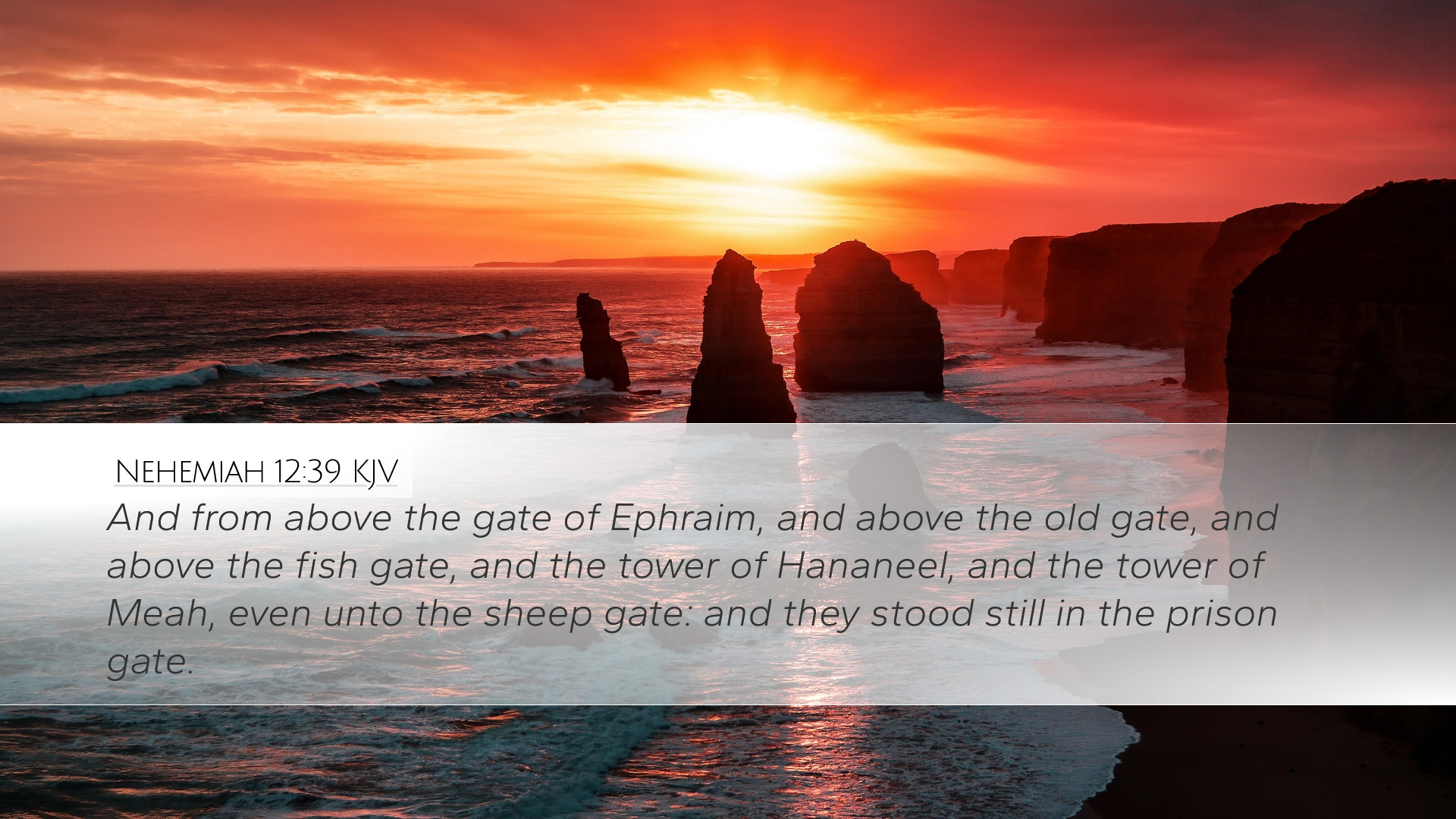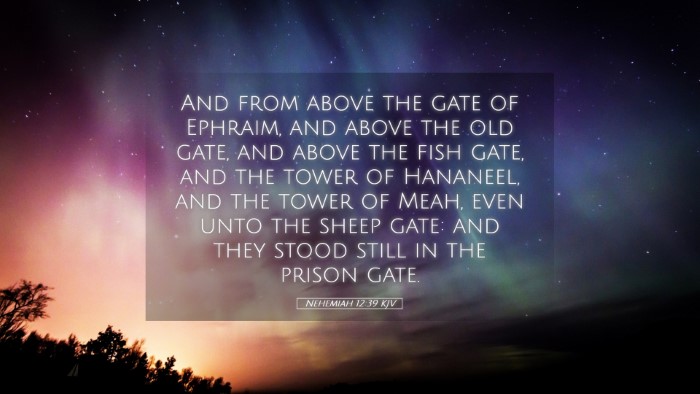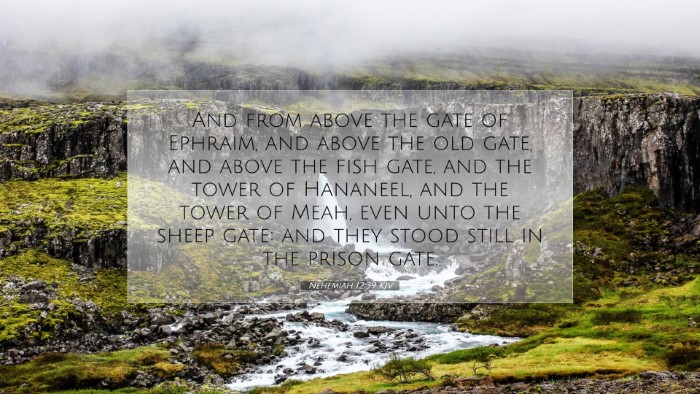Commentary on Nehemiah 12:39
The verse Nehemiah 12:39 states: "and the gate of Ephraim, the gate of Jeshanah, the gate of Miklat, and the gate of the hundred were by the tower of Hananel, and the tower of the hundred, even unto the sheep gate." This passage forms a significant part of Nehemiah's account of the re-establishment of Jerusalem after the Babylonian captivity, highlighting the dedication and fortification of the city.
Historical Context
The return of the exiles from Babylon, under the leadership of Nehemiah and Ezra, was a pivotal moment for the Jewish people. After years of destruction and desolation, the rebuilding of Jerusalem was essential not only for their physical safety but also for their spiritual renewal. Nehemiah's narrative addresses the restoration of religious practices and community identity.
Commentary Insights
1. The Significance of Gate Symbolism
Matthew Henry, in his esteemed commentary, points out that gates in the biblical context are not merely physical structures; they symbolize entry points into community and worship. Each gate mentioned—Ephraim, Jeshanah, Miklat, and the hundred—carries with it cultural significance and harkens back to specific tribes. The gates serve not only functional roles but are also emblematic of the tribes' badges of honor and identity.
2. The Towers as Symbols of Defense and Watchfulness
Albert Barnes discusses the strategic placement of the towers and gates. The tower of Hananel and the tower of the hundred were likely constructed not just for aesthetics but as vigilant watch points to protect the city from potential threats. They embody the combination of spiritual and physical readiness that characterized the returning exiles. The defensive structure of the city correlates with the spiritual fortifications being reconstructed through the re-establishment of the Law and temple worship.
3. The Journey of Restoration
Adam Clarke emphasizes the collective journey of the Israelites in rebuilding Jerusalem. The gates represent stages in their restoration process. Clarke notes that the attention to detail in describing the locations showcases the efforts made by individuals and communities in reclaiming their heritage. It serves as a metaphor for the ongoing work required in spiritual restoration. Each step taken towards fortifying Jerusalem echoes the inner restoration of faith among the people.
Theological Implications
The rebuilding of Jerusalem and its gates can be viewed through a theological lens, where it reflects broader themes of redemption and restoration in Scripture. The historical narrative undergirds the hope of renewal not just for the city but for the covenant people themselves.
1. God's Faithfulness
The act of rebuilding signifies God's unwavering faithfulness to His covenant. It illustrates the principle found throughout the Scriptures that regardless of the circumstances—including exile and sin—God’s promise stands firm. The gates and towers signify that even amid destruction, God provides a way back to Him, akin to the salvific work in the New Testament through Christ.
2. Community and Identity
As the people navigate their restored identity, the gates illustrate their communal experience. The communal effort in restoration speaks to the necessity of unity in faith as they worked together toward a common goal. This essence of community as a representation of God’s work remains essential in the church today, reminding congregations of their collective purpose and covenant identity.
3. A Foreshadowing of Christ
Nehemiah's focus on the gates and the ensuing protection provided by the walls and towers can also be seen as a foreshadowing of Christ, the ultimate gatekeeper. John 10:9 states, "I am the door. If anyone enters by Me, he will be saved, and will go in and out and find pasture." The gates serve as a precursor to the greater reality of entering into a relationship with God through Christ, who provides spiritual safety amid worldly dangers.
Practical Applications for Pastors and Theologians
-
Encouragement of Community Efforts:
Just as the Israelites worked together to rebuild, pastors are encouraged to foster a cohesive community focus within their congregations, emphasizing collaboration in missions and outreach.
-
Teaching on Spiritual Restoration:
This passage invites the church to reflect on the theme of restoration and how it applies to individual lives. Sermons can focus on how God can rebuild and renew anyone who turns back to Him.
-
Inviting Reflection on Identity in Christ:
Pastors are reminded to help their congregations understand their identity in Christ, paralleling the way these gates symbolize the lost identity of Israel now becoming restored.
Conclusion
Nehemiah 12:39, while detailing the gates of Jerusalem, opens up a profound opportunity for reflection on community, God’s faithfulness, and the importance of identity. The insights gathered from Matthew Henry, Albert Barnes, and Adam Clarke provide a multi-faceted view of this passage that is vital for pastors, scholars, and students alike. In understanding the historical and theological significance of the gates, we are reminded of God’s redemptive path through history, culminating in the salvation offered through Jesus Christ.


